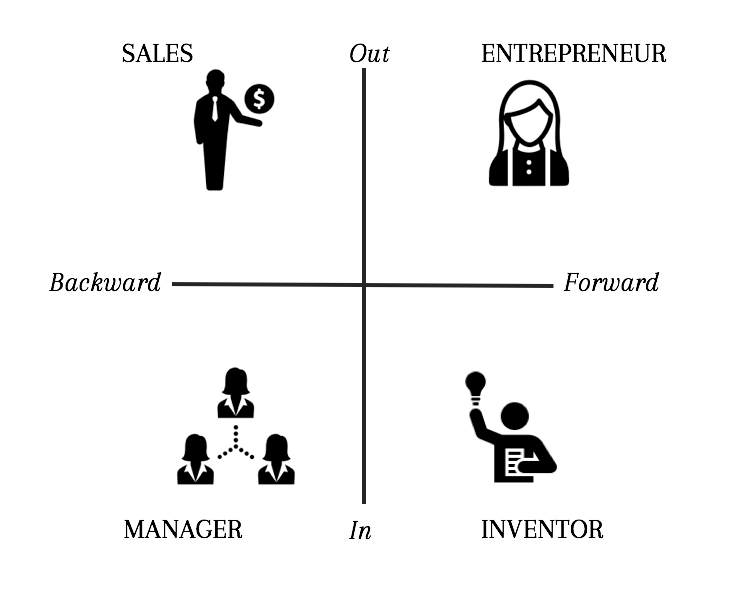17 Nov The gravitational pull of mental paradigms
We have previously written about different organisational perspectives or mental paradigms that dominate your organisation. There are of course many ways to frame this, but the following 2×2 gives one possible way.

A forward-looking company sees the future coming, keeps track of new tech trends and is up to date with what impactful startups are doing.
An outward–looking company sees and understands their customer and other external stakeholders extremely well.
A backward-looking company looks at what has worked in the past and what is the “normal” and established way to do thing.
An inward-looking company looks at its’ own capabilities, resources and culture.
When two of these perspectives merge and becomes the dominant way to see the world, a particular mindset gets established.
The sales mindset is customer focused and always keen to deliver what the company already produces. A sales-focused company that builds its’ own products typically have a very fragmented feature set, the result of the company trying to please every customers demand all the time.
The manager mindset is all about control and predictable structure. The manager looks at what worked last year and tries to improve it. A company with a manager mindset is in constant optimisation mode, trying to fine tune a machinery that has been running for a while.
The inventor mindset is common in engineering driven tech companies. This company often has an impressive patent portfolio but the actual usefulness of the patents (except as legal protection) is debatable.
The entrepreneur mindset is all about constantly looking out for new solutions to customers. The tricky balance is to be just about visionary enough to inspire and deliver actual new value and not be too far ahead of where the customers are, a balance that a good entrepreneurial company manages to achieve.
We believe strongly in building entrepreneurial companies. This is the essence of what Lean Forward is all about. That is the only way to avoid the inevitable demise that comes with stagnation. The problem, as we see it, is that the entrepreneur is a missing species at most companies. The dominant mindset is one of the other kinds, with manager being the probable number one in occurrence.
Still, the entrepreneur can not run a big and successful company by herself. The other three mindsets are also important. The question is just which one is dominate? This can be seen in the behaviour of the executive team. Who gets promoted? What is the incentive structure in the company? What behaviour gets rewarded at the yearly internal conferences?
Each mindset has its own gravitational pull that moves the company in a certain direction. It attracts a certain type of individual. It enforces a certain type of organisational habits. Breaking those habits is what an organisational transformation is all about, regardless of if you call it “agile” or “digital“.

Buildings are structured but so are the patterns of waves hitting the shoreline. It is just a very different kind of structure.
What you want is a company that can do continuous transformation and the only way to achieve that is to make the entrepreneur mindset the dominant one – with the strong support of the other three. This will be the dominant type of company in the 21st century, just as Tayloresque management was during the 20th century. The time to start transforming is now.


